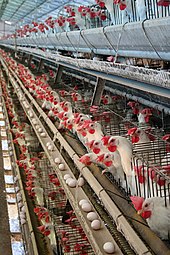
Back تربية الدواجن Arabic Quşçuluq təsərrüfatı Azerbaijani Птушкагадоўля Byelorussian मुर्गी पालन Bihari Drůbežnictví Czech Geflügelproduktion German Granja avícola Spanish Linnukasvatus Estonian پرورش ماکیان Persian कुक्कुट पालन Hindi

| Agriculture |
|---|
 |
|
|
Poultry farming is the form of animal husbandry which raises domesticated birds such as chickens, ducks, turkeys and geese to produce meat or eggs for food. Poultry – mostly chickens – are farmed in great numbers. More than 60 billion chickens are killed for consumption annually.[2][3] Chickens raised for eggs are known as layers, while chickens raised for meat are called broilers.[4]
In the United States, the national organization overseeing poultry production is the Food and Drug Administration (FDA). In the UK, the national organisation is the Department for Environment, Food and Rural Affairs (DEFRA).

- ^ Appleby, M.C.; Hughes, B.O.; Elson, H.A. (1992). Poultry Production Systems: Behaviour, Management and Welfare. CAB International.
- ^ "Global Animal Slaughter Statistics And Charts". Faunalytics. October 10, 2018. Retrieved November 5, 2019.
- ^ "Compassion in World Farming – Poultry". Ciwf.org.uk. Retrieved October 3, 2018.
There are more chickens in the world than any other bird. In fact, more than 50 billion chickens are reared annually as a source of food, for both their meat and their eggs.
- ^ "Compassion in World Farming – Poultry". Ciwf.org.uk. Retrieved October 3, 2018.
Chickens farmed for meat are called broiler chickens, whilst those farmed for eggs are called egg-laying hens.